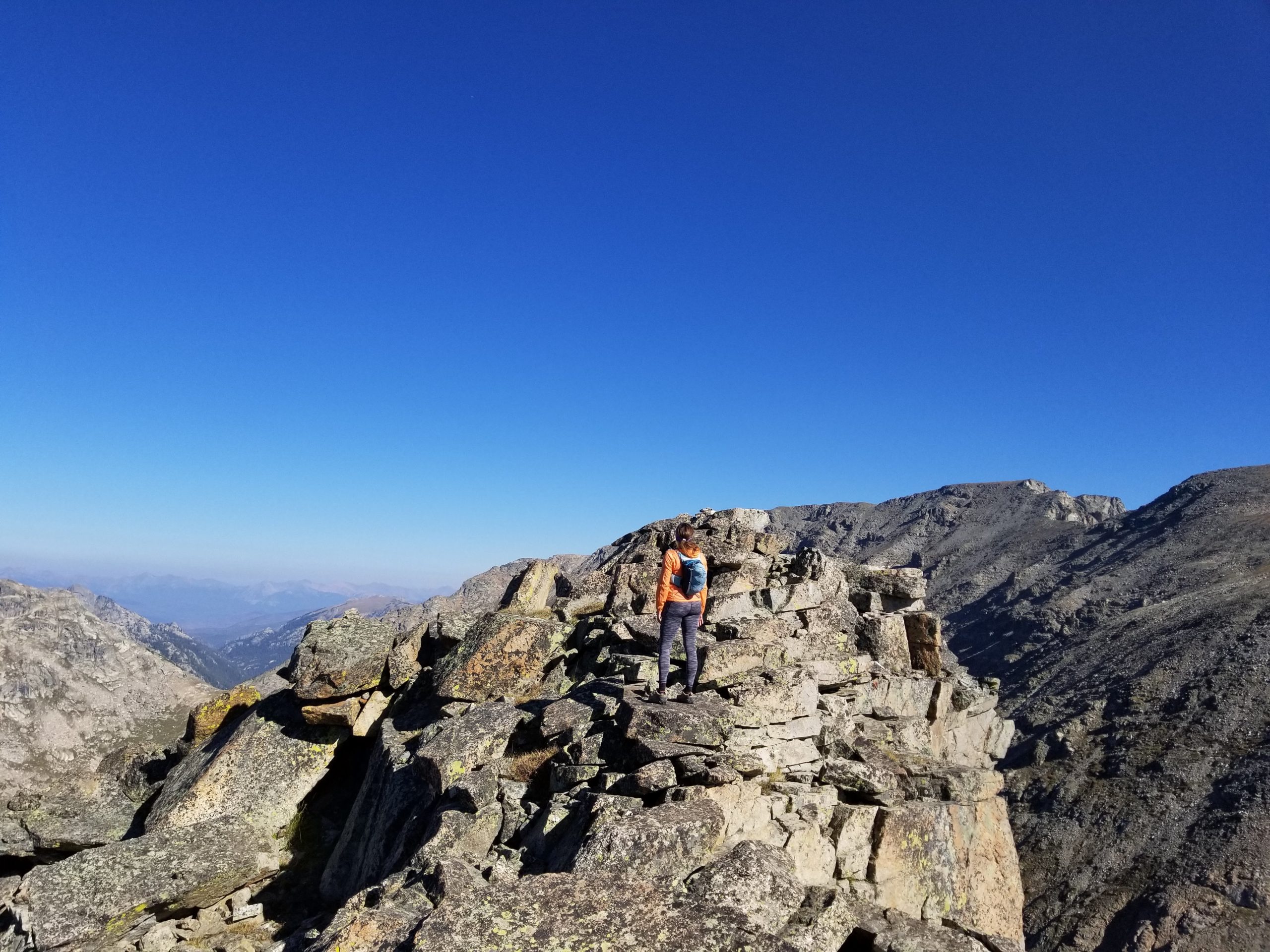
Cooper Peak (12,296’) is located deep in the heart of the Indian Peaks Wilderness (IPW). A hard-earned trip to its remote summit embodies the very best of Colorado backcountry exploration: a scenic approach hike, camping at one of the most beautiful lakes in the Rocky Mountains, challenging route-finding, and an exciting ridge scramble to its surprisingly accommodating summit block.
Climbing Cooper Peak isn’t a technical endeavor but it’s not for beginners. Ropes are not needed along the standard route to the summit, which is rated Class 2+ and requires hand-and-feet scrambling. This adventure is not recommended for novice explorers due to the intriguing off-trail navigation. But for those who have strong navigational skills—and a good fitness level—a visit to this isolated pocket of the IPW is a masterclass in backcountry hiking bliss.
Round-trip mileage to the summit and back is 20.8 miles. The majority of that distance (8 miles one-way/16 miles total) is actually on-trail en route to the incongruously-named Gourd Lake. Tucked on a high shelf and surrounded by an amphitheater of pine-speckled whitish-gray granite, the lake is fed by modest cascades that flow down from a series of ponds that are higher still. Standing guard over this scenic realm is the imposing southern shoulder of Cooper, its true summit hidden from view.
It is recommended to plan two or three days for this adventure. Three days is ideal, as it gives you two nights at Gourd Lake (see permit details at right). Even though the round-trip voyage to Cooper’s summit from Gourd Lake is only 4 miles, that distance is traveled mostly off-trail and through a series of tricky basins—it’s quite easy to get turned around, especially on the return visit. It’s nice to not have to tack on the 8-mile walk back to your vehicle on summit day, thus the suggestion for a second overnight.
Cooper Peak Hike Guide
Hiking into Gourd Lake is straightforward. Starting from the Monarch Lake Trailhead on the west side of the IPW, follow the Buchanan Pass Trail to the Gourd Lake Trail to Gourd Lake basecamp. You’ll need a permit to camp here. The area is rarely crowded but the best campsites go quickly on summer weekends. The good news is there is nice camping around the entire perimeter of the lake. The bad news is that you may have to haul your heavy backpack on rooty, occasionally steep social trails to reach the farther out campsites
After a good night’s sleep, start early on summit day (no later than 6 a.m.). Don’t be fooled by the low mileage, there’s a lot of work ahead. Find a social trail on the north side of the lake that heads up into a high basin. Most of the traffic that does come through here is headed to Island Lake, another IPW hidden gem.
The route to Cooper Peak, however, goes the opposite way from Island Lake. The faint trail ends and the rest of the route will be off-trail as it heads west/northwest down into a magical, remote basin. Persistent granite cliffs require savvy to work around. Aiming west helps drop into the basin without getting cliffed out. In this high basin, the saddle between Cooper Peak and nearby 12,041-foot Marten Peak hangs as a low point on the horizon. Marten Peak is a nice bonus summit for strong hikers and features a spicy summit block that requires easy Class 3 scrambling.

By now the character of Cooper Peak has changed significantly from the fortress-like appearance it had from Gourd Lake. From the saddle an imposing ridgeline curves northeast, leading directly to the top. Thankfully, a neatly hidden gully reveals itself and cuts just below the ridge proper, making for a nice Class 2+ scramble up to the broad, flat shoulder of the mountain. From this vantage, both the true summit and the spacious plateau of the south shoulder become apparent (it’s worth a short 10-minute detour to stand on the shoulder and gaze down at your campsite at
Gourd Lake).
The final push to the summit follows the open slopes to a chunky, slightly exposed summit block. The views here are outstanding and if you’re lucky, the sun will display shimmering, diamond flashes on Island Lake far below.
The return hike begins easily enough—go back to the saddle on the Marten/Cooper Ridge. Drop back into the high basin. Remain vigilant in retracing your steps back to the east/southeast. Several hikers have gotten lost in this area and descended into the wrong basin. You’ll have to climb back up to the rocky flats before regaining the trail back down to Gourd Lake. From the lake, it’s back on-trail to your vehicle at Monarch Lake Trailhead, 8
miles away.
Cooper Peak isn’t a well-known summit and it takes some real moxie to reach, but it is nonetheless one of the most spectacular summit journeys in the Rocky Mountains. It’s perfect for a three-day weekend, especially in early autumn. Just remember to get your permits and reserve your spot at Gourd Lake at least three weeks in advance.
Details, Details:
Fees and Permits
The Indian Peaks Wilderness requires a backcountry permit From June 1–Sept. 15. Backcountry permits must be acquired in advance through Recreation.gov (recreation.gov/permits/4675318) and cost $11 as of 2022. Permits should be acquired at least three weeks in advance, though they may be obtained up to three days prior to your trip if available. Make your reservation for Gourd Lake in the Buchanan backcountry zone. Be sure to bring your printed permit.
Overnight parking at Monarch Lake
Trailhead is free. There are no facilities at Gourd
Lake and about 12 established dispersed campsites.














